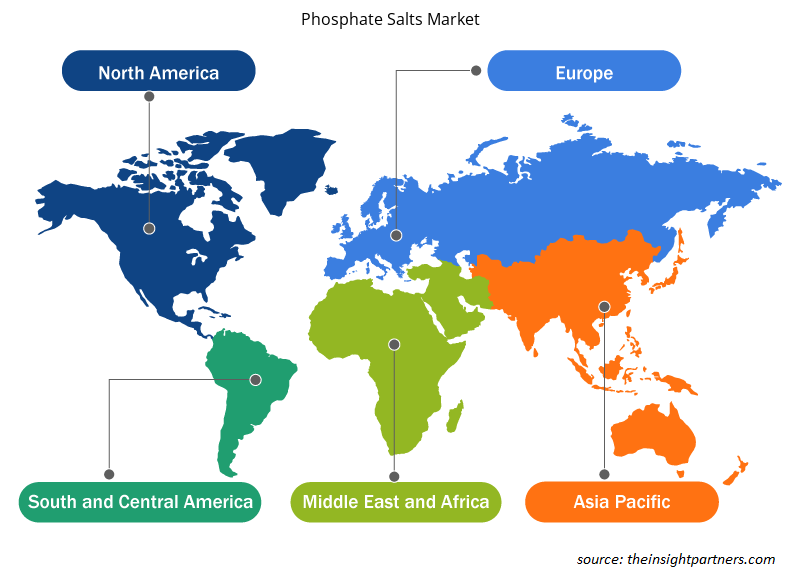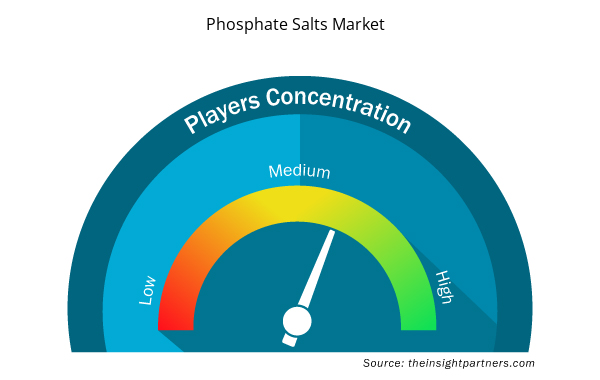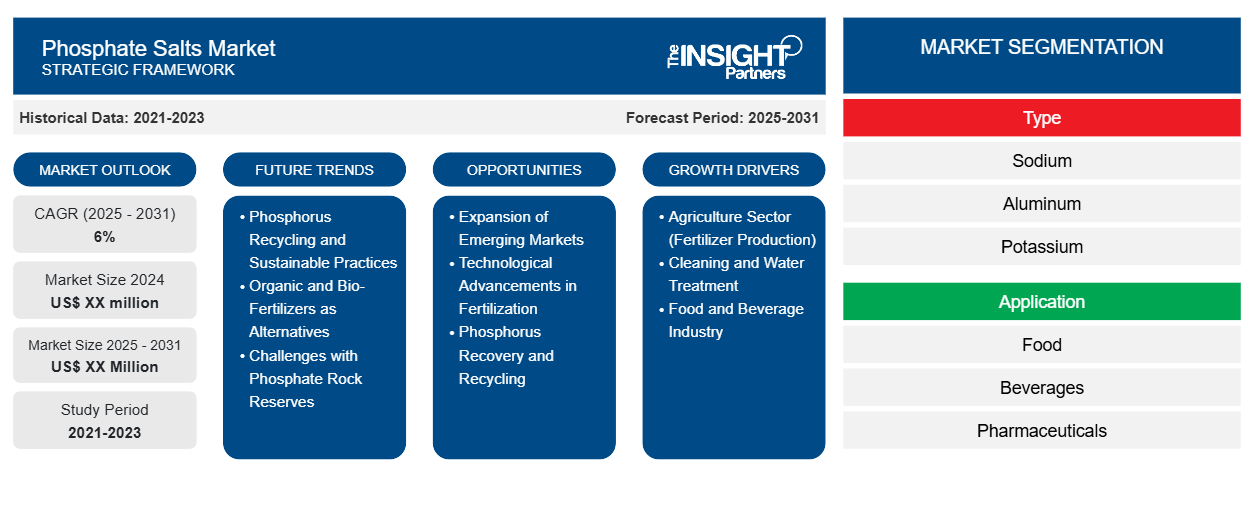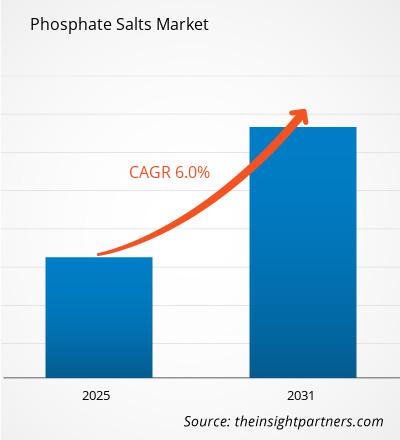Der Markt für Phosphatsalze wird voraussichtlich von 2023 bis 2031 eine durchschnittliche jährliche Wachstumsrate (CAGR) von 6 % verzeichnen, wobei die Marktgröße von XX Millionen US-Dollar im Jahr 2023 auf XX Millionen US-Dollar bis 2031 wachsen wird.
Der Marktbericht zu Phosphatsalzen ist nach Typ (Natrium, Aluminium, Kalium, Kalzium, Ammonium und andere) segmentiert. Der Markt ist nach Anwendung segmentiert [Lebensmittel (Milchprodukte, Backwaren, Fleisch, Geflügel und Meeresfrüchte, andere), Getränke, Pharmazeutika, Wasseraufbereitung, Landwirtschaft, Textilien, Farben und Beschichtungen, Reinigungsmittel und andere]. Die globale Analyse ist weiter auf regionaler Ebene und in die wichtigsten Länder unterteilt. Die Marktgröße und -prognose auf globaler, regionaler und Länderebene für alle wichtigen Marktsegmente werden im Rahmen abgedeckt. Der Bericht bietet den Wert in USD für die oben genannte Analyse, Segmente, Regionen und Länder. Der Bericht deckt Markttrends sowie Marktdynamiken wie Treiber, Beschränkungen und wichtige Chancen ab. Der Bericht deckt auch die Branchenlandschaft und Wettbewerbsanalyse ab, einschließlich Marktkonzentration, Heatmap-Analyse, prominenter Akteure und jüngster Entwicklungen auf dem Markt.
Zweck des Berichts
Der Bericht Phosphatsalzmarkt von The Insight Partners zielt darauf ab, die gegenwärtige Landschaft und das zukünftige Wachstum sowie die wichtigsten treibenden Faktoren, Herausforderungen und Chancen zu beschreiben. Dies wird verschiedenen Geschäftspartnern Einblicke geben, wie zum Beispiel:
- Technologieanbieter/-hersteller: Um die sich entwickelnde Marktdynamik zu verstehen und die potenziellen Wachstumschancen zu kennen, damit sie fundierte strategische Entscheidungen treffen können.
- Investoren: Durchführung einer umfassenden Trendanalyse hinsichtlich der Marktwachstumsrate, der finanziellen Marktprognosen und der Chancen entlang der Wertschöpfungskette.
- Regulierungsbehörden: Sie regulieren Richtlinien und polizeiliche Maßnahmen auf dem Markt mit dem Ziel, Missbrauch zu minimieren, das Vertrauen der Anleger zu bewahren und die Integrität und Stabilität des Marktes aufrechtzuerhalten.
Phosphatsalze Marktsegmentierung
Typ
- Natrium
- Aluminium
- Kalium
- Kalzium
- Ammonium
Anwendung
- Essen
- Getränke
- Pharmazeutika
- Wasseraufbereitung
- Landwirtschaft
- Textil
- Farben und Lacke
- Waschmittel
Passen Sie diesen Bericht Ihren Anforderungen an
Sie erhalten kostenlose Anpassungen an jedem Bericht, einschließlich Teilen dieses Berichts oder einer Analyse auf Länderebene, eines Excel-Datenpakets sowie tolle Angebote und Rabatte für Start-ups und Universitäten.
- Holen Sie sich die wichtigsten Markttrends aus diesem Bericht.Dieses KOSTENLOSE Beispiel umfasst eine Datenanalyse von Markttrends bis hin zu Schätzungen und Prognosen.
Wachstumstreiber auf dem Phosphatsalzemarkt
- Landwirtschaftssektor (Düngemittelproduktion): Der Landwirtschaftssektor ist der größte Nachfragetreiber für Phosphatsalze, vor allem für die Produktion von phosphatbasierten Düngemitteln. Phosphor wird oft als der zweithäufigste Nährstoff für Nutzpflanzen nach Stickstoff bezeichnet und spielt eine wichtige Rolle für das Pflanzenwachstum, während Phosphatsalze die Nutzpflanzenproduktion steigern und aufrechterhalten, indem sie die Bodenfruchtbarkeit verbessern. Aufgrund der schnell wachsenden Weltbevölkerung erfordert ihre Versorgung mehr Nahrung, was zu einer höheren Produktivität in der Landwirtschaft führt. Dieses Wachstum in der globalen Landwirtschaft, insbesondere in den Entwicklungsregionen der Welt, ist einer der Faktoren, die das Wachstum auf dem Markt für Phosphatsalze fördern, da jeder Landwirt danach strebt, mehr Nutzpflanzen zu produzieren und die hungrige Bevölkerung zu ernähren.
- Reinigung und Wasseraufbereitung: Phosphatsalze sind in diesem Fall Stoffe, die in allen Arten von Wasch- und Reinigungsmitteln, in der Wasseraufbereitung und in anderen Industrien Anwendung finden. Sie dienen als Wasserenthärter, Stabilisatoren und Dispergiermittel, um die Wirksamkeit der Produkte zu verbessern. Die oben genannten Faktoren tragen zur erhöhten Nachfrage nach Phosphatsalzen in diesen Industrien bei, die auf die zunehmende Industrialisierung und Urbanisierung in den Entwicklungsländern und den Fortschritt bei Haushalts- und Industriereinigungsprodukten zurückzuführen ist. Im Zuge der Stadtentwicklung und Industrialisierungsprozesse, in denen Reinigung bzw. Wasseraufbereitung wichtig sind, gibt es für die Verwendung von Phosphatsalzen in der Industrie einen lebendigen Markt.
- Lebensmittel- und Getränkeindustrie: Phosphatsalze werden im Lebensmittel- und Getränkesektor im Allgemeinen in Form von Konservierungsmitteln, Texturverstärkern und Geschmacksverstärkern in Lebensmittelprodukte eingearbeitet. Sie helfen, den Feuchtigkeitsverlust von Fleisch zu verhindern, verbessern die Qualität von kohlensäurehaltigen Getränken und dienen als Backpulver in verpackten Kuchen. Verarbeitete Lebensmittel und Fastfood erfreuen sich bei den Verbrauchern zunehmender Beliebtheit, daher ist zu erwarten, dass der Lebensmittel- und Getränkesektor in naher Zukunft mehr Phosphatsalze verwenden wird.
Zukünftige Trends auf dem Phosphatsalzmarkt
- Phosphorrecycling und nachhaltige Praktiken: Da die Landwirtschaft weltweit mit Problemen konfrontiert ist, die die ökologische Nachhaltigkeit und die Ressourcenverfügbarkeit beeinträchtigen, ist die Nachfrage nach grünen oder umweltfreundlichen Düngemitteln stark gestiegen. Die Gewinnung von Phosphaten und die Herstellung von Düngemitteln können negative Auswirkungen auf die Umwelt haben, darunter Bodenerosion und Wasserverschmutzung. Daher konzentriert sich der Sektor nun auf umweltfreundlichere Lösungen, darunter die Herstellung anorganischer Düngemittel mit recyceltem Phosphor anstelle des Abbaus neuer Phosphaterze und die Verbesserung der nachhaltigen Praktiken beim Abbau von Phosphatsalzen. Es besteht erhebliches Potenzial für Verbesserungen bei Technologien zur Umwandlung von Abfällen in Düngemittel und bei Phosphorquellen neben dem Bergbau, z. B. beim Recycling von Phosphatgestein.
- Organische und Biodünger als Alternativen: Die zunehmende Nutzung biologischer Landwirtschaftspraktiken wiederum erhöht den Bedarf an biologischen und organischen Düngemitteln, da diese keine düngemittelaktiven Inhaltsstoffe mit synthetischen Phosphaten enthalten. In der biologischen Landwirtschaft werden keine Chemikalien wie Düngemittel verwendet und daher in großem Umfang Phosphatsalze verwendet, die in der Natur vorkommen und durch einen biologischen Prozess hergestellt werden. Dies ist Teil der wachsenden Stimmung gegenüber Veränderungen in landwirtschaftlichen Praktiken, die umweltfreundlicher und gesundheitsfreundlicher sind. Da die Verbraucher zunehmend Biolebensmittel bevorzugen, wird erwartet, dass sich organische oder natürliche Phosphatsalze in den unerschlossenen Randbereichen des Weltmarkts gut verkaufen.
- Herausforderungen bei Phosphatgesteinsreserven: Aufgrund der Bedenken hinsichtlich der schwindenden Phosphatgesteinsreserven und der Umweltauswirkungen des Phosphatabbaus haben die Rückgewinnung und das Recycling von Phosphor an Bedeutung gewonnen. Es werden derzeit fortgeschrittene Entwicklungen durchgeführt, um Systeme zu entwickeln, die Abwasser, Klärschlamm und landwirtschaftliche Abwässer zur Rückgewinnung von Phosphor nutzen. Solche Ökoprojekte mildern die Umweltauswirkungen und fördern zudem die Kreislaufwirtschaft. Es genügt zu sagen, dass mit der Verknappung des Phosphatgesteins auch der Zugang zu neuen Phosphorquellen durch die Rückgewinnung und das Recycling vorhandener Abfallstoffe in den Produkten der Phosphatsalzindustrie knapper wird.
Marktchancen für Phosphatsalze
- Expansion der Schwellenmärkte: Mit der zunehmenden industriellen Nutzung wird der Markt für Phosphatsalze in den Regionen Asien-Pazifik, Lateinamerika und Afrika, die als Schwellenmärkte eingestuft werden, voraussichtlich wachsen. In vielen Bereichen hat das Bevölkerungswachstum Investitionen in die Landwirtschaft erforderlich gemacht, und in der Entwicklung der Landwirtschaft werden mehr Düngemittel eingesetzt. Das Wachstum umfasst auch die industrielle Entwicklung, die die Nachfrage nach Phosphatsalzen beispielsweise in Reinigungsmitteln, Wasseraufbereitungsmitteln und Shampoos erhöht. Diese Märkte können von Herstellern erschlossen werden, indem sie billige, verfügbare und wenn möglich lokale Phosphatsalze verkaufen, die den lokalen Anforderungen entsprechen.
- Technologische Fortschritte bei der Düngung: Aufgrund von Faktoren wie der wachsenden Nachfrage nach effektiveren und umweltfreundlicheren landwirtschaftlichen Verfahren besteht ein erhebliches Verbesserungspotenzial für die Düngetechnologie. Phosphatsalze stehen im Mittelpunkt dieses Wandels, da sich die Industrie bei der Herstellung von Düngemitteln auf langsam lösliche Granulate konzentriert und außerdem auf die Taktik der Präzisionslandwirtschaft setzt, die versucht, nährstoffsparend zu sein. Die sorgfältige Entwicklung von Phosphatsalzen, um entweder eine verbesserte Aufnahme durch die Pflanzen oder eine langsame Freisetzungsrate zu erreichen, minimiert die Verschwendung von Düngemitteln und maximiert die Erträge. Dies eröffnet den Unternehmen die Möglichkeit, neue Produkte auf den Markt zu bringen.
- Rückgewinnung und Recycling von Phosphor: Da sich die Umweltprobleme und die ökologische Nachhaltigkeit im Zusammenhang mit dem konventionellen Abbau von Phosphaten verschärfen, gibt es viele gute Aussichten für Investitionen in die Rückgewinnung und das Recycling von Phosphor. Die Rückgewinnung von Phosphor aus Abfallquellen (z. B. die Rückgewinnung von Phosphor aus kommunalen Abwasseraufbereitungsanlagen und landwirtschaftlichen Abflüssen) wird der Industrie helfen, den Bergbau zu reduzieren und gleichzeitig eine nachhaltige Bewirtschaftung des Phosphors zu fördern. Diese Möglichkeit ist ein Spiegelbild der weltweiten Bemühungen, eine Kreislaufwirtschaft und Abfallwirtschaft zu praktizieren, und bietet daher sowohl wirtschaftliche als auch ökologische Vorteile.
Regionale Einblicke in den Phosphatsalzmarkt
Die regionalen Trends und Faktoren, die den Phosphatsalzmarkt während des Prognosezeitraums beeinflussen, wurden von den Analysten von Insight Partners ausführlich erläutert. In diesem Abschnitt werden auch die Marktsegmente und die Geografie des Phosphatsalzmarkts in Nordamerika, Europa, im asiatisch-pazifischen Raum, im Nahen Osten und Afrika sowie in Süd- und Mittelamerika erörtert.

- Holen Sie sich die regionalspezifischen Daten für den Phosphatsalzmarkt
Umfang des Marktberichts über Phosphatsalze
| Berichtsattribut | Details |
|---|---|
| Marktgröße im Jahr 2023 | XX Millionen US-Dollar |
| Marktgröße bis 2031 | XX Millionen US-Dollar |
| Globale CAGR (2023 - 2031) | 6 % |
| Historische Daten | 2021-2022 |
| Prognosezeitraum | 2024–2031 |
| Abgedeckte Segmente | Nach Typ
|
| Abgedeckte Regionen und Länder | Nordamerika
|
| Marktführer und wichtige Unternehmensprofile |
|
Dichte der Marktteilnehmer für Phosphatsalze: Auswirkungen auf die Geschäftsdynamik verstehen
Der Markt für Phosphatsalze wächst rasant, angetrieben durch die steigende Endverbrauchernachfrage aufgrund von Faktoren wie sich entwickelnden Verbraucherpräferenzen, technologischen Fortschritten und einem größeren Bewusstsein für die Vorteile des Produkts. Mit steigender Nachfrage erweitern Unternehmen ihr Angebot, entwickeln Innovationen, um die Bedürfnisse der Verbraucher zu erfüllen, und nutzen neue Trends, was das Marktwachstum weiter ankurbelt.
Die Marktteilnehmerdichte bezieht sich auf die Verteilung der Firmen oder Unternehmen, die in einem bestimmten Markt oder einer bestimmten Branche tätig sind. Sie gibt an, wie viele Wettbewerber (Marktteilnehmer) in einem bestimmten Marktraum im Verhältnis zu seiner Größe oder seinem gesamten Marktwert präsent sind.
Die wichtigsten auf dem Markt für Phosphatsalze tätigen Unternehmen sind:
- Die Mosaik-Firma
- OCP-Gruppe
- EuroChem Group AG
- Israel Chemicals Ltd.
- Nutrien Ltd.
Haftungsausschluss : Die oben aufgeführten Unternehmen sind nicht in einer bestimmten Reihenfolge aufgeführt.

- Überblick über die wichtigsten Akteure auf dem Phosphatsalzemarkt
Wichtige Verkaufsargumente
- Umfassende Abdeckung: Der Bericht deckt die Analyse von Produkten, Dienstleistungen, Typen und Endbenutzern des Phosphatsalze-Marktes umfassend ab und bietet einen ganzheitlichen Überblick.
- Expertenanalyse: Der Bericht basiert auf dem umfassenden Verständnis von Branchenexperten und Analysten.
- Aktuelle Informationen: Der Bericht stellt durch die Abdeckung aktueller Informationen und Datentrends Geschäftsrelevanz sicher.
- Anpassungsoptionen: Dieser Bericht kann angepasst werden, um spezifische Kundenanforderungen zu erfüllen und die Geschäftsstrategien optimal anzupassen.
Der Forschungsbericht zum Phosphatsalzmarkt kann daher dabei helfen, die Branchensituation und Wachstumsaussichten zu entschlüsseln und zu verstehen. Obwohl es einige berechtigte Bedenken geben kann, überwiegen die allgemeinen Vorteile dieses Berichts tendenziell die Nachteile.
- Historische Analyse (2 Jahre), Basisjahr, Prognose (7 Jahre) mit CAGR
- PEST- und SWOT-Analyse
- Marktgröße Wert/Volumen – Global, Regional, Land
- Branche und Wettbewerbsumfeld
- Excel-Datensatz



Report Coverage
Revenue forecast, Company Analysis, Industry landscape, Growth factors, and Trends

Segment Covered
This text is related
to segments covered.

Regional Scope
North America, Europe, Asia Pacific, Middle East & Africa, South & Central America

Country Scope
This text is related
to country scope.
Häufig gestellte Fragen
Focus on sustainable fertilizer solutions are expected to be the key market trends.
Based on application, the agriculture segment is expected to witness the fastest growth during the forecast period.
Based on geography, Asia Pacific held the largest share of the phosphate salts market due to the strong growth of the food, beverage, and agriculture industry in the region.
Growing demand in agriculture is driving the market growth.
ICL, Innophos, Haifa Group, Merck KGaA, Reephos Chemical Co Ltd, Fengchen Group Co Ltd, Omnisal Gmbh, Airedale Group, Jost Chemical Co, and Aditya Birla Chemicals are the key players operating in the phosphate salts market.
The Phosphate Salts Market is estimated to witness a CAGR of 6% from 2023 to 2031
Trends and growth analysis reports related to Chemicals and Materials : READ MORE..
The Insight Partners performs research in 4 major stages: Data Collection & Secondary Research, Primary Research, Data Analysis and Data Triangulation & Final Review.
- Data Collection and Secondary Research:
As a market research and consulting firm operating from a decade, we have published and advised several client across the globe. First step for any study will start with an assessment of currently available data and insights from existing reports. Further, historical and current market information is collected from Investor Presentations, Annual Reports, SEC Filings, etc., and other information related to company’s performance and market positioning are gathered from Paid Databases (Factiva, Hoovers, and Reuters) and various other publications available in public domain.
Several associations trade associates, technical forums, institutes, societies and organization are accessed to gain technical as well as market related insights through their publications such as research papers, blogs and press releases related to the studies are referred to get cues about the market. Further, white papers, journals, magazines, and other news articles published in last 3 years are scrutinized and analyzed to understand the current market trends.
- Primary Research:
The primarily interview analysis comprise of data obtained from industry participants interview and answers to survey questions gathered by in-house primary team.
For primary research, interviews are conducted with industry experts/CEOs/Marketing Managers/VPs/Subject Matter Experts from both demand and supply side to get a 360-degree view of the market. The primary team conducts several interviews based on the complexity of the markets to understand the various market trends and dynamics which makes research more credible and precise.
A typical research interview fulfils the following functions:
- Provides first-hand information on the market size, market trends, growth trends, competitive landscape, and outlook
- Validates and strengthens in-house secondary research findings
- Develops the analysis team’s expertise and market understanding
Primary research involves email interactions and telephone interviews for each market, category, segment, and sub-segment across geographies. The participants who typically take part in such a process include, but are not limited to:
- Industry participants: VPs, business development managers, market intelligence managers and national sales managers
- Outside experts: Valuation experts, research analysts and key opinion leaders specializing in the electronics and semiconductor industry.
Below is the breakup of our primary respondents by company, designation, and region:

Once we receive the confirmation from primary research sources or primary respondents, we finalize the base year market estimation and forecast the data as per the macroeconomic and microeconomic factors assessed during data collection.
- Data Analysis:
Once data is validated through both secondary as well as primary respondents, we finalize the market estimations by hypothesis formulation and factor analysis at regional and country level.
- Macro-Economic Factor Analysis:
We analyse macroeconomic indicators such the gross domestic product (GDP), increase in the demand for goods and services across industries, technological advancement, regional economic growth, governmental policies, the influence of COVID-19, PEST analysis, and other aspects. This analysis aids in setting benchmarks for various nations/regions and approximating market splits. Additionally, the general trend of the aforementioned components aid in determining the market's development possibilities.
- Country Level Data:
Various factors that are especially aligned to the country are taken into account to determine the market size for a certain area and country, including the presence of vendors, such as headquarters and offices, the country's GDP, demand patterns, and industry growth. To comprehend the market dynamics for the nation, a number of growth variables, inhibitors, application areas, and current market trends are researched. The aforementioned elements aid in determining the country's overall market's growth potential.
- Company Profile:
The “Table of Contents” is formulated by listing and analyzing more than 25 - 30 companies operating in the market ecosystem across geographies. However, we profile only 10 companies as a standard practice in our syndicate reports. These 10 companies comprise leading, emerging, and regional players. Nonetheless, our analysis is not restricted to the 10 listed companies, we also analyze other companies present in the market to develop a holistic view and understand the prevailing trends. The “Company Profiles” section in the report covers key facts, business description, products & services, financial information, SWOT analysis, and key developments. The financial information presented is extracted from the annual reports and official documents of the publicly listed companies. Upon collecting the information for the sections of respective companies, we verify them via various primary sources and then compile the data in respective company profiles. The company level information helps us in deriving the base number as well as in forecasting the market size.
- Developing Base Number:
Aggregation of sales statistics (2020-2022) and macro-economic factor, and other secondary and primary research insights are utilized to arrive at base number and related market shares for 2022. The data gaps are identified in this step and relevant market data is analyzed, collected from paid primary interviews or databases. On finalizing the base year market size, forecasts are developed on the basis of macro-economic, industry and market growth factors and company level analysis.
- Data Triangulation and Final Review:
The market findings and base year market size calculations are validated from supply as well as demand side. Demand side validations are based on macro-economic factor analysis and benchmarks for respective regions and countries. In case of supply side validations, revenues of major companies are estimated (in case not available) based on industry benchmark, approximate number of employees, product portfolio, and primary interviews revenues are gathered. Further revenue from target product/service segment is assessed to avoid overshooting of market statistics. In case of heavy deviations between supply and demand side values, all thes steps are repeated to achieve synchronization.
We follow an iterative model, wherein we share our research findings with Subject Matter Experts (SME’s) and Key Opinion Leaders (KOLs) until consensus view of the market is not formulated – this model negates any drastic deviation in the opinions of experts. Only validated and universally acceptable research findings are quoted in our reports.
We have important check points that we use to validate our research findings – which we call – data triangulation, where we validate the information, we generate from secondary sources with primary interviews and then we re-validate with our internal data bases and Subject matter experts. This comprehensive model enables us to deliver high quality, reliable data in shortest possible time.


 Holen Sie sich ein kostenloses Muster für diesen Bericht
Holen Sie sich ein kostenloses Muster für diesen Bericht